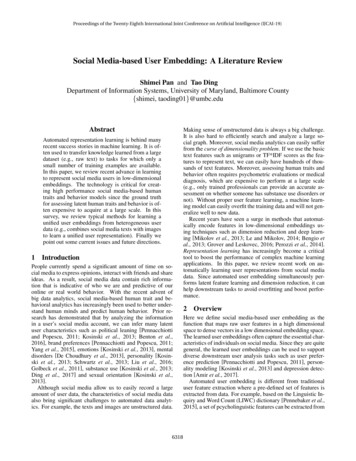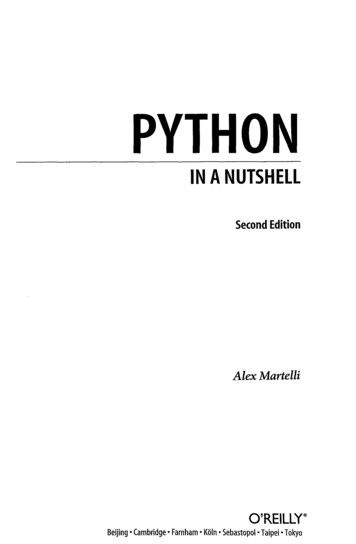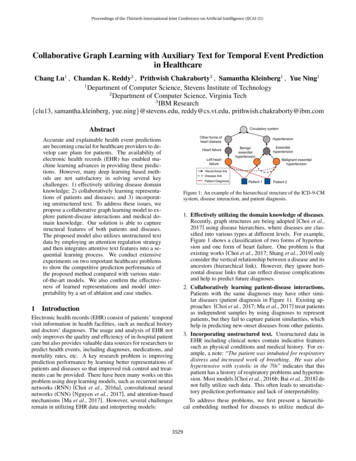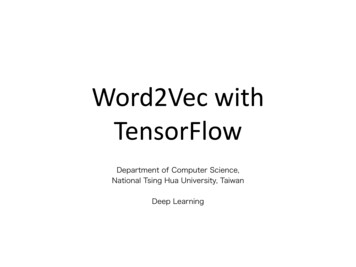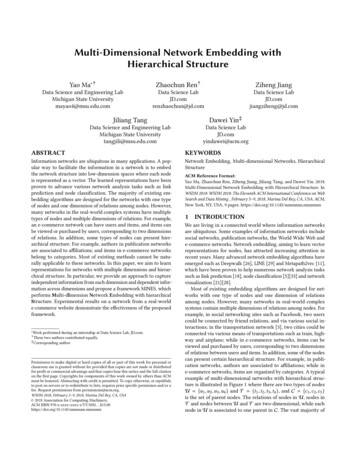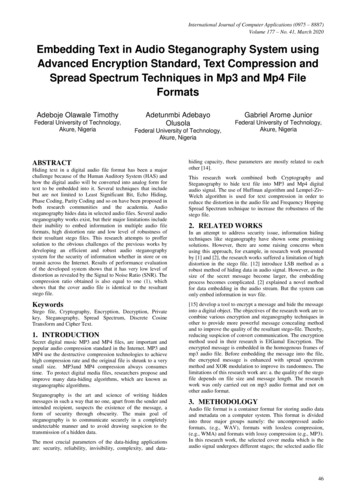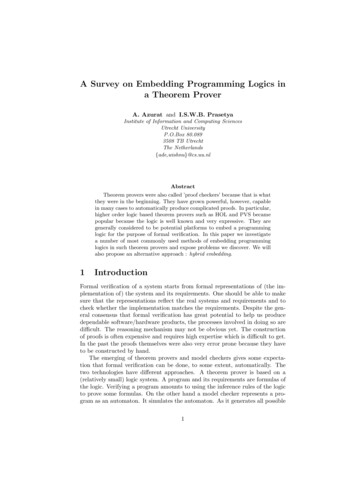
Transcription
A Survey on Embedding Programming Logics ina Theorem ProverA. Azurat and I.S.W.B. PrasetyaInstitute of Information and Computing SciencesUtrecht UniversityP.O.Box 80.0893508 TB UtrechtThe Netherlands{ade,wishnu}@cs.uu.nlAbstractTheorem provers were also called ’proof checkers’ because that is whatthey were in the beginning. They have grown powerful, however, capablein many cases to automatically produce complicated proofs. In particular,higher order logic based theorem provers such as HOL and PVS becamepopular because the logic is well known and very expressive. They aregenerally considered to be potential platforms to embed a programminglogic for the purpose of formal verification. In this paper we investigatea number of most commonly used methods of embedding programminglogics in such theorem provers and expose problems we discover. We willalso propose an alternative approach : hybrid embedding.1IntroductionFormal verification of a system starts from formal representations of (the implementation of) the system and its requirements. One should be able to makesure that the representations reflect the real systems and requirements and tocheck whether the implementation matches the requirements. Despite the general consensus that formal verification has great potential to help us producedependable software/hardware products, the processes involved in doing so aredifficult. The reasoning mechanism may not be obvious yet. The constructionof proofs is often expensive and requires high expertise which is difficult to get.In the past the proofs themselves were also very error prone because they haveto be constructed by hand.The emerging of theorem provers and model checkers gives some expectation that formal verification can be done, to some extent, automatically. Thetwo technologies have different approaches. A theorem prover is based on a(relatively small) logic system. A program and its requirements are formulas ofthe logic. Verifying a program amounts to using the inference rules of the logicto prove some formulas. On the other hand a model checker represents a program as an automaton. It simulates the automaton. As it generates all possible1
states reachable by the program, it verifies if those states fulfil the program’srequirements[6].Model checkers are good in finding errors because they are highly automated,but they tend to have problems in representing infinite state spaces and infinitedata structures (such as unbounded integers, strings, or lists). Theorem provers,in particular those based on a rich expression language, have no problem withinfinite states and data structures. A theorem prover is also much more secureas it is based on a relatively small core logic. Theorem provers basically provide no automation. Their primary function is to check proofs supplied by theuser rather than constructing the proofs themselves. Modern theorem provers,however, come with meta languages which can be used to program automaticproof generation. There are also some initiative to integrate theorem proversand model checkers.1.1What this Paper is AboutTo do formal verification of a program we need a programming logic. To do sowith an existing theorem prover we usually need to embed the programming logicfirst in the theorem prover1 . This is because the logic used by the theorem proveris typically not a programming logic. The purpose of this paper is to surveycommonly used techniques for such embeddings. We will focus on theoremprovers which are based on a higher order predicate logic. This class of theoremprovers seems to be very popular because the logic is well known and its higherorder feature makes it very expressive. Two embedding techniques are to bedistinguished known: shallow and deep embedding. Both turn to be problematic.We will show the problems, by using concrete examples. In the examples wewill assume the use of the HOL theorem prover, which is representative for theabove mentioned class of theorem provers.We will also explain an alternative approach, which we call hybrid embedding.In this approach only the semantics of a programming logic is embedded in atheorem prover. The syntactic machinery of the logic is implemented outsidethe theorem prover.1.2A Note on NotationIn order to show concrete examples of embedding we assume the HOL system isused as the host logic. We will however strip irrelevant HOL notational detailsfrom the code to give minimum distraction to non-HOL readers.1 This is not to be confused with the term embedded system which means a piece of hardwareor software embedded as a component of an autonomous control system –such as the controlsystem of a steam boiler. While the term embedding in this paper refers to a logic embeddedinside another logic.2
2EmbeddingIn the formal verification community, mechanizing a logic means implementingthe logic in a computer. The intent is to get the computer to check the wellformedness of our formulas and the correctness of our proofs. This means,among other things, that the inference rules of the logic have to be implementedin the computer. Mechanization does not necessarily imply proof automation.Embedding mechanizes a logic L by encoding L and its semantics insideanother, already mechanized logic L0 , and in effect ’borrows’ the mechanizationof L0 . We will call the logic L the guest logic and L0 the host logic.Having the semantics represented in the host logic is what separates embedding from ordinary mechanization. It allows the verification of the soundness ofthe guest logic L in L0 . The inference rules of L are represented as formulas ofL0 , so they can be verified just like any other L0 formula.Typically, we want a host logic to be expressive so that we can use it torepresent (embed) a wide range of guest logics. We also want it to be small:it provides a minimum set of language constructs to express formulas and aminimum set of inference rules. This is for security reasons. Its primitivenessmakes it much easier for us to convince ourselves of the soundness of the hostlogic. Obviously it is not safe to build an embedding on a host logic withquestionable soundness. The HOL system [9] is an example of a theorem proverbased on a small, yet very expressive logic (a higher order, typed predicatelogic). Note that once proven, an embedded logic inherits the soundness of itshost.Unfortunately a minimalistic host logic also creates another problem. A programming logic is typically based on high level programming and specificationlanguages. Encoding sentences of these languages as sentences of a more primitive language of the host logic can seriously reduce readability –an aspect thatmakes formal methods, in particular theorem provers, not very welcome in theindustrial world[6].Embedding also inherits the problem of formal semantics. The semantics of areal programming language is very complicated, raising the issue of maintainingthe correctness and the reliability of the semantics itself. We quote here from[23]:”Our EML experience suggests that, at least at the present time,tackling the problems of specification and formal development in areal programming language at a fully formal level is just too difficult.This seems to leave two ways forward: either remain fully formal butfocus on a smaller and simpler language, perhaps building up fromthis gradually to something approaching a real language; or remainwith a real language, but give up trying to achieve full formality.”In the theorem prover community, people often distinguish between so-calledshallow and deep embedding [3]. Shallow embedding of a logic L embeds the3
semantics of L but does only a minimal effort to represent the grammar2 (syntax) L in L0 . Deep embedding embeds also the syntactic structures of the logiccompletely. The exact representation (e.g. whether we represent states withfunctions or records) may influence how much of the syntactic structures of theformulas of the guest logic can be maintained in the embedding –so people alsospeak of the depth of an embedding. Grammar is represented much better indeep embedding, as it uses functional data types to represent the grammar –itis known that there is strong correspondence between (context free) grammarsand recursive data types [8]. Because of the explicit representation of the grammar, in deep embedding it is possible to encode and verify syntactic operationsand analyses made on the formulas of the guest logic. This is not possible withshallow embedding. Unfortunately deep embedding has its own problems. Forexample, it takes lots of effort to set up. Changing the syntax of the guest logicmay also incur lots of work.In some theorem provers, such as COQ, there is no deep-shallow dichotomy[16]. COQ is based on a type system, which is even more primitive than thelogic used by, for example, the HOL system. The disadvantage is that a guestlogic must now be represented in an even more primitive language, which willfurther reduce the readability of the representations.Lots of work has been invested in embedding in the past 10 years. We willmention some achievements –there are too many to mention all of them.In [2, 21, 25], Andersen, Prasetya and Vos reported the embedding of the programming logic UNITY in HOL –UNITY is a simple logic [5] for reasoning abouttemporal properties of distributed systems. Andersen, Prasetya and Vos haveused their embedding to mechanically verify non-trivial distributed algorithms.Furthermore, Prasetya also uses embedding to verify a rich self-stabilization theory, and Vos does the same for refinement theory. The embeddings are shallow,though Vos has a deeper embedding by having typed program variables moreexplicitly represented.An example of deep embedding is the embedding of a simple imperativeprogramming language called Sunrise in HOL by Homeier and Martin [11]. AVerification Condition Generator (VCG) is supplied, based on a method namedDiversion Verification Condition to provide total correctness of mutually recursive functions. The VCG basically does a syntactic transformation on theSunrise’s programs and specification. It has been proven sound in HOL, whichis only possible because of the deep embedding of Sunrise. However, the extendibility issue was not covered yet. So far the language only has numericdata type and list constructor, but even then the soundness proof of the VCGalready involves 8 new types, 217 definitions, and 906 major theorems, usingover 57,000 lines of proof, organized in 22 HOL theories.An attempt to use embedding for a real programming language and logicwas recently reported by Huisman [12] who embeds Java (without threads) inPVS and Isabelle. The embedding is part of a larger tool called LOOP. LOOP2 The grammar of a language is a set of rules specifying how the formulas of the languageare constructed.4
features a specification language for Java, called JML [13], and compilers tocompile a Java program and its JML specifications to their embedded representations.3Shallow EmbeddingShallow embedding concentrates on how the semantics of the guest logic canbe represented in a theorem prover. It is less concerned with various syntacticstructures and constraints of the guest logic. Compared to deep embedding,shallow embedding takes much less work to set up. It is suitable when usedin the initial phase of the development of a programming logic in which manyfeatures are still experimental. The languages of the logic and its inference rulesare still unstable and we constantly need to verify the logic’s consistency aftereach modification. It is still suitable for actual program verification work if thelanguage used by the guest logic is still simple, such as the case in [21] wheretarget programs are just flat structured UNITY programs.To give a more concrete illustration of the approach, consider a very simpleprogramming logic –abbreviated VSPL– described in Figure 1. The logic is toosimple to be used in practice, but it will serve our purpose here. A shallowembedding of this logic will be given later. We will assume the HOL system tobe used as the host logic.A VSPL program is either a skip, an assignment, or a (possibly nested)if-then-else statement. There are only two kinds of values in VSPL: booleansand integers. VSPL expressions are very limited, with only , , , , and as operators. Specifications are expressed in terms of Hoare triples with theusual interpretation. We also add one more kind of specification, which is aspecification of the form [P ] where P is a boolean expression (predicate). Sucha specification means that the predicate P is a tautology –so it holds on allpossible states of a program. When used exhaustively, the inference rules ofVSPL will reduce any Hoare triple specification into a specification of the form[P ]. Although not explicitly mentioned in its description in Figure 1, VSPLassumes the availability of a mechanism to prove specifications of the latterform.Remember that in embedding we need to have a semantics of the guest logic.This is because we basically embed a logic by writing its semantics as formulasof the host logic. The steps we typically have to perform are:1. Identifying various semantic domains of the guest logic.2. Describing the semantics in detail and encoding it in the host logic.3. Representing and verifying the inference rules of the guest logic.The amount of detail we want to put in the semantics may depend on theapplication of the guest logic. For example, the execution models of most imperative programming language typically include a program counter to keep track5
1. Grammar:Stmt ::Exprskip Identifier : Expr if Expr then Stmt else Stmt:: Spec::Expr ExprExpr ExprExpr ExprExpr Expr ExprBoolInteger{Expr } Stmt {Expr } [ Expr ]2. Inference rules:[P Q]{P } skip {Q}Skip RuleAssignment Rule[P Q[E/x]]{P } x : E {Q}If-then-else Rule{P g} A {Q} , {P g} B {Q}{P } if g then A else B {Q}Figure 1: VSPL6
of the control location of a program during its execution. In some setup, suchas when concurrency is an issue, we may have to explicitly include programcounters in the semantics. However if we only deal with sequential programsspecified by Hoare triples, such as in VSPL, we can hide the program counterfrom the semantics.There are many ways one can define the semantics of the same programminglogic. In some representations, programs variables are represented by first classvalues in the host logic. Depending on the application this can be an importantaspect. We need first class representation of variables names in order to express syntactic constraints on the set of variables of a program. They are quiteuseful and occur quite often as conditions in program transformations, composition, and refinements. On the other hand, approaches in which variables arenot represented as first class values typically produce cleaner representationsof programs and specifications. We will show examples of both approaches.There are also approaches which are somewhat in between, e.g. Huisman usesthe combination of records and functions [12]. We will not cover this kind ofapproach.4Shallow Embedding IThis section will show a shallow embedding of VSPL in HOL using an approachwhere VSPL variables are represented by first class HOL values.4.1Step 1: Identifying Semantic DomainsA state of a program at a given moment describes the values of the program’svariables at that moment. We can represent a state by a function from variables to values. We can use string to represent variables (actually, variables’names)3 . This representation is quite simple and is used by many others, e.g.[2, 17, 21, 25]. Alternatively, one can also use lists to represent states.Since VSPL only has two kind of values, booleans and integers, we canrepresent VSPL values in HOL with the following HOL data type:Code 4.1 :datatype Value IB fromInt int fromBool bool2However, if we use this specific data-type the resulting embedding of VSPLinference rules will only work on that specific representation of data values: theycannot be reused if one decides to extend VSPL with new types of data values.To allow reuse, we can represent VSPL data values with a HOL type variable3 Although we will not do this here, for concrete applications it is typically useful to maintainseparate lists to keep track which variables a given program owns and what their access modesare.7
which can later be instantiated by some concrete HOL type. Alternatively,we can represent VSPL data values by a specific HOL type whose property isnow left unspecified and later we provide injections to, for example, integersand booleans. Both approaches are almost equivalent. The second approach isslightly more flexible4 , so we will focus on it.So, assume an unspecified HOL type Value representing all possible datavalues of VSPL programs. An expression is evaluated on a state and returns thevalue of the expression in that state. So, a VSPL expression will be representedby a function from state to value.VSPL statements are deterministic. They can be represented by functionsthat take an initial state and return a new state (in other settings where statements are non-deterministic, or may block, relations can be used). Finally, aVSPL specification will semantically be represented by a boolean value, since aspecification is either valid (true) or invalid (false).To summarize, these are our semantic domains:Definition 4.2 : Semantic domains of VSPLtypetypetypetypeStateExprPredStmt stringStateStateState- - - - ValueValueboolState24.2Step 2: Specifying the SemanticsA semantics assigns meaning to each syntactic category of a language. Forexample, the following gives the semantics of VSPL statements in terms of thesemantic domains given in Definition 4.2:VSPL statementsskipif g then A else Bx Esemantics(\s. s)(\s. if (g s) then A s else B s)(\s. (\v. if v x then E s else s v))where s is of type State.This semantics can be directly translated to HOL. For each syntactic construct of Stmt we introduce a new HOL constant to represent it. The semanticsis then assigned to each constant as its definition. So this is how VSPL statements are represented in HOL:4 In both approaches the inference rules are reusable. However, in the first approach –in which the space of VSPL data values is represented by a type variable, say, V – programsverified based on a concrete instance T1 of V cannot be composed with programs verified basedon a different instance T2 of V . One will have to upgrade both programs using a commonand larger base T3 . However, verification of both programs will have to be re-executed.Alternatively, one can also provide mappings between T1 , T2 and T3 .8
Definition 4.3 : Semantics of StmtSKIPIF g THEN A ELSE Bx ASG E (\s. s)(\s. if (g s) then A s else B s)(\s. (\v. if v x then E s else s v))2VSPL specifications can be represented as follows:Definition 4.4 : Semantics of SpecVALID PHOA A P Q (!s. P s)(!s. P s Q (A s))2where HOA A P Q represents a specification of the form {P } A {Q} and VALIDP represents a specification of the form [P ].Expressions, in particular boolean valued expressions (predicates) can berepresented as follows:Definition 4.5 : Semantics of Exprp AND qp IMP qNOT p (\s. p s /\ q s)(\s. p s q s)(\s. p s)2where AND, IMP, and NOT represent VSPL’s , , and . The bounded variables is of type State.In shallow embedding we may not want to represent all syntactic structuresof the guest logic. Notice that the inference rules of VSPL only assumes theexistence of , , and operators with their respective arities. The inferencerules do not care about other syntactic structures that Expr may have. So, forthe purpose of verifying the soundness of VSPL we do not need to representthose other syntactic structures of Expr (such as the operators and ) andto provide their semantics.4.3Step 3: Representing and Verifying Inference RulesVSPL’s inference rules can be represented by HOL formulas. Proving theseformulas essentially justifies the soundness of the inference rules they represent.The formula representation may seem inadequate, since rules are computationentities (they accept VSPL specifications and produce new specifications) andformulas are plain data. However, once proven, the resulting theorems can be’executed’ by applying them to some VSPL specifications. Applying a HOLtheorem is usually done by calling some combination of HOL’s own inferencerules for Modus Ponens and Substitution.9
1. Skip-rule - (P Q) HOA SKIP P Q2. Cond-rule. - HOA A (P AND g) Q/\HOA B (P AND NOT g) Q HOA (IF g THEN A ELSE B) P Q3. Assign-rule - VALID (p IMP (q o (x ASG E))) HOA (x ASG E) p qFigure 2: VSPL’s inference rules in HOLFigure 2 shows the resulting HOL theorems, representing VSPL’s inferencerules.Proving those inference rules in HOL is very easy. Essentially we just rewritethem using their own definitions (using their own semantics) and then call HOL’ssimplifier and first order prover. As example, here is the proof code of theCond-rule:prove--‘HOA A (P AND g) Q /\ HOA B (P AND NOT g) Q HOA (IF g THEN A ELSE B) P Q‘--,RW TAC std ss [HOA def,IFTHENELSE def,AND def,NOT def]THEN PROVE TAC[]);4.4Representing Programs and SpecificationsThe shallow embedding of VSPL is now set. We can use it to represent andverify concrete VSPL programs. Consider the following VSPL specification:Example 4.6 :{b (x y)}10
if x y then x x 1 else y y 1{b (x 1 y)}2One may expect to represent, for example, the post condition b (x 1 y)like this:(\s. s "b") AND NOT(\s. s "x" 1 s "y")However this is not type correct. It requires states to be functions returningboolean values (as in s "b") as well as integers (as in s "x" 1). This isalso not consistent with the typing of states: we have decided that they arefunctions from State to Value. Fortunately we have left the property of Valueunspecified in the semantics. We can now say that it is at least large enough tocontain booleans and integers, and furthermore we also have constructors anddestructors to construct a Value from a boolean or integer vice-versa. We canimpose on the existence of the following functions:Definition 4.7 : Constructors and Destructors of ValuefromIntfromBooltoInttoBool::::int- Valuebool- ValueValue- IntValue- Boolwith the expected property that each from- function forms an injection andtheir respective from- counterparts form the inverses.2Now we can correctly represent the specification in the Example 4.6 as follows:Code 4.8 :HOA(IF (\s. (toInt o s) "x" (toInt o s) "y")THEN ("x" ASG (fromInt o (\s. (toInt o s) "x" 1)))ELSE ("y" ASG (fromInt o (\s. (toInt o s) "y" 1))))((\s. (toBool o s) "b") ANDNOT(\s. (toInt o s) "x" (toInt o s) "y"))((\s. (toInt o s) "b") ANDNOT(\s. (toInt o s) "x" 1 (toInt o s) "y"))211
The reader may notice that expressions at the right hand side of an assignmentis translated differently from the guard of an if-then-else, pre-condition, andpost-condition. The latter are always boolean typed expressions (predicates).On the other hand, an expression at the right hand side of an assignment can beof any type, which in this embedding is represented by a function that returns aValue. Because, for example, (\s. (toInt o s) "x" 1) returns an integer,we still need the function fromInt to cast the result to Value.4.5Verifying ProgramsSpecifications such as the one in Example 4.6 are verified by successively applying the guest logic’s inference rules in a certain order. In the case of VSPL thiscan be easily automated in HOL. We can write something like this:(REPEAT o FIRST o map MATCH MP TAC)[SKIP thm, ASG thm, IFTHENELSE thm]where, for example, SKIP thm is the HOL theorem representing the inferencerule for the skip statement. The above HOL code will repeatedly apply VSPLinference rules until no further application is possible. How much automationwe can get depends largely on the guest logic itself. In any case, HOL comeswith a powerful meta language.In the case of VSPL, exhaustively applying the rules do not prove the specification, yet. Rather, this step produces a specification of the form VALID P.After unfolding the definition of VALID we will get a verification ’goal’ of theform P s which has to be proven for an arbitrary s. For example, for thespecification in Example 4.6 the following goal will be produced:Code 4.9 :((toBool ((toInt((toInt (toBool ((toInto s) "b"o s) "x" (toInt o s) "y")o s) "x" (toInt o s) "y")(toBool ((toInt ((toInt (toBool ((toInto s) "b"o s) "x" (toInt o s) "y")o s) "x" (toInt o s) "y")/\/\o s) "b"/\o s) "x" 1 1 (toInt o s) "y"))/\(/\/\o s) "b"/\o s) "x" 1 (toInt o s) "y" 1))which has to be proven to hold for an arbitrary s.212
The formula represents:(b (x y) (x y) b (x 1 1 y)) (b (x y) (x y) b (x 1 y 1))The above can be easily proven in HOL. Note that from this point on the proofno longer depends on the structure of the program. Instead, it depends onthe properties of the data values –in this case the properties of booleans andintegers.There are also a number of subtle points about the to- and the fromfunctions. Consider the specification:Example 4.10 :{ x 0 }x x 1 { x 1 }which is represented by this HOL formula in the embedding:HOA("x" ASG (fromInt o (\s. (toInt o s) "x" 1)))(\s. (toInt o s) "x" 0)(\s. (toInt o s) "x" 1)2After applying the ASG Rule to the specification above, and after some trivialsimplifications, we will get this as a goal:Code 4.11 :VALID((\s. (toInt o s) "x" 0)IMP(\s. toInt (fromInt ((toInt o s) "x" 1)) 1))2The goal above cannot be proven if we cannot reduce the expression at theright hand side of the implication to (\s. (toInt o s) "x" 1 1). Thefollowing three properties are necessary to enable this reduction1. The to- and the from- functions have to be distributive. For example,we have to be able to reduce:toInt (fromInt ((toInt o s) "x" 1))to:toInt (fromInt (toInt o s) "x")13 toInt (fromInt 1)
2. The fact that the to- functions are injections with their respective fromcounterparts as inverses is crucial, otherwise we cannot, for example, reduce toInt (fromInt 1) to 1.3. We need to add an explicit assumption that s "x" is a Value within thedomain of toInt. This can also be seen as a requirement for the author ofthe program to confirm to HOL that x is indeed an integer valued variable.Without this assumption we cannot reduce:toInt (fromInt (toInt o s) "x")to (toInt o s) "x"4.5.1Syntax ExtensionWhat if we want to extend the syntax of the guest logic? For example, let usextend VSPL by adding the sequential composition operator ’;’ for statements.So the syntax of the Stmt is now extended as shown below. We also need a newinference rule to deal with the new operator.Example 4.12 :Stmt::Seq Rule:skip Identifier : Expr if Expr then Stmt else Stmt Stmt ; Stmt{P } A {Q} , {Q} B {R}{P } A ; B {R}2To represent ’;’ we need to add a new HOL constant and assign some meaning to it:Definition 4.13 : Semantics of ;SEQ A B B o A2The new inference rule can be represented in the same way existing VSPLrules are represented in HOL, namely by the formula:HOA A P Q /\ HOA B Q R HOA (SEQ A B) P Rwhich can be proven with as much ease as we prove the other rules.Note that incrementally extending the syntax of the guest logic does notrequire existing shallow embedding to be rebuilt. As we will see later, thisproperty does not hold for deep embedding.14
4.5.2Value Space ExtensionVSPL only supports two kinds of data values: booleans and integers. Whatif we want to add new types? As an example, let us add the type of lists ofintegers. We also extend the syntax of Expr with a few list operators as shownbelow. No new inference rule is introduced.Example 4.14 :Expr:: Expr ExprExpr ExprExpr ExprExpr Expr ExprExpr :: Expr[]BoolInteger/* add a new element to a list *//* make an empty list */2Note that since we have no inference rules that require evaluation of a listexpression, there is no need to explicitly add the list operators in the embedding(like we did to, for example, the and the operators).To represent programs and specifications that contain list expressions weneed to extend our assumptions on Value. Recall that this is an unspecifiedHOL type representing all possible data values of VSPL programs. Since wenow also have lists of integers we need to add an assumption that Value is alsolarge enough to include all lists of integers. We can do this by imposing theexistence of the following two functions:Definition 4.15 : Value to List InjectionfromIntListtoIntList: Int list- Value: Value- Int listwith the property that toIntList is an injection and fromIntList is its inverse.2Here is an example of a program that does something with lists and its representation:Example 4.16 :A VSPL program:if z [] then skip else z 1 :: zIts representation:IF (\s. (toIntList o s) "z" [])THEN SKIPELSE ("x" ASG (\s. 1 :: (toIntList o s) "z"))15
2It would be nice to have other kind of lists, e.g. lists of booleans or nestedlists. The elegant way to get this is by adding polymorphic types to VSPL.Unfortunately embedding polymorphism in a theorem prover such as HOL isproblematic. For example, suppose now we want to extend VSPL’s lists so thattheir elements can have an arbitrary type (so we can have lists of booleanstoo, and multi level lists). We will have to add the following constructor anddestructor to the type Value:Code 4.17 :fromListtoList: ’a list- Value: Value- ’a list2where ’a denotes a type variable.Since ’a is variable, it can be Value itself. No injective function fromListcan be provided without introducing the Russel paradox5 .This is very unfortunate. Polymorphism is very useful to specify generalproperties of programs, or to specify programs that build sophicticated datastructures, e.g. distributed programs (building spanning trees) and databaseprog
An attempt to use embedding for a real programming language and logic was recently reported by Huisman [12] who embeds Java (without threads) in PVS and Isabelle. The embedding is part of a larger tool called LOOP. LOOP 2The grammar of a language is a set of rules specifying how the formulas of the language are constructed. 4
